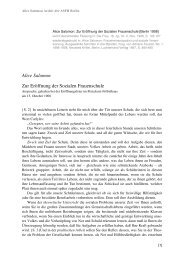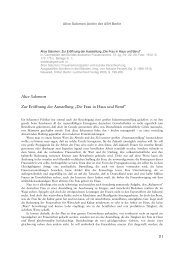Teaching Gender in Social Work - MailChimp
Teaching Gender in Social Work - MailChimp
Teaching Gender in Social Work - MailChimp
You also want an ePaper? Increase the reach of your titles
YUMPU automatically turns print PDFs into web optimized ePapers that Google loves.
Heather Widdows 10 emphasises that it is not easy to def<strong>in</strong>e reproductive<br />
rights – they are absent from the Universal Declaration of Human Rights and<br />
at a European level there is no consensus on what reproductive rights are and<br />
who is responsible for provid<strong>in</strong>g such rights. Even so, everybody agrees on<br />
the importance of reproductive health. Heather Widdows 11 notices that five of<br />
the fundamental issues <strong>in</strong> reproductive rights <strong>in</strong> the contemporary context are<br />
abortion, adoption, birth rate, teenage pregnancy and the rights of m<strong>in</strong>ority.<br />
She argues that it is important to note that women’s reproductive rights are<br />
l<strong>in</strong>ked to other rights – political, social and economic rights. But reproductive<br />
rights are central to any concept of women’s rights. For example, women’s rights<br />
to economic stability depend upon whether a woman can postpone childbirth<br />
(if she wishes) until she is established <strong>in</strong> a career or stable relationship (rights<br />
to reproductive autonomy) as well as upon social situations and <strong>in</strong>stitutions<br />
(such as the state provision of childcare and social assumptions about the role<br />
of women).<br />
Personal Desires and National Goals Related to Human Reproduction<br />
Fertility control is of great <strong>in</strong>terest to both nation states and <strong>in</strong>dividuals, but<br />
their goals are not always the same. Nations have been <strong>in</strong>terested <strong>in</strong> both<br />
limit<strong>in</strong>g and <strong>in</strong>creas<strong>in</strong>g population size at different po<strong>in</strong>ts <strong>in</strong> their histories.<br />
Fertility control issues at the state level are mediated by nationalist <strong>in</strong>terests and<br />
contested by <strong>in</strong>dividual citizens. States, both on the local and national levels<br />
have great <strong>in</strong>terest <strong>in</strong> their population characteristics. For both pragmatic and<br />
ideological reasons, a country’s population is a critical resource concern<strong>in</strong>g its<br />
quantity, quality and vitality. In many countries, explicit policies are implemented<br />
when the population is determ<strong>in</strong>ed by those hav<strong>in</strong>g power to be too<br />
large or too small, or <strong>in</strong> some other way, a “problem”. The <strong>in</strong>troduction of state<br />
natalist policies often have un<strong>in</strong>tended consequences and/or differential effects<br />
on the various groups the policies are supposed to affect. Natalism or probirth<br />
is a belief that promotes human reproduction; it may comprise pro-natalist<br />
policies, that is, national efforts to <strong>in</strong>crease population, or anti-natalist policies,<br />
that is, national efforts to decrease population, usually by reduc<strong>in</strong>g the birth<br />
10<br />
Heather Widdows, “Introduction”, <strong>in</strong> Women’s reproductive rights (Women’s rights <strong>in</strong> Europe), eds. Heather Widdows,<br />
Itziar Alkorta Idiakez and Aitziber Emaldi Cirión, (Palgrave Macmillan, 2006), 1-16.<br />
11<br />
Ibid.<br />
148














